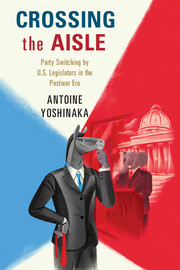Book contents
- Frontmatter
- Dedication
- Contents
- List of Tables
- List of Figures
- Acknowledgments
- PART I
- 1 Legislative Party Switching in the United States: An Introduction
- 2 Party Switching: A Theoretical Framework
- PART II
- PART III
- PART IV
- Appendix A Excluded “Pseudo-Switchers”
- Appendix B Details about Elite Interviews
- Appendix C Data Sources for Chapter 3
- Appendix D Data Sources for Chapter 4
- Appendix E Data Sources for Chapter 5
- Appendix F Data Sources for Chapter 6
- References
- Index
1 - Legislative Party Switching in the United States: An Introduction
from PART I
Published online by Cambridge University Press: 05 December 2015
- Frontmatter
- Dedication
- Contents
- List of Tables
- List of Figures
- Acknowledgments
- PART I
- 1 Legislative Party Switching in the United States: An Introduction
- 2 Party Switching: A Theoretical Framework
- PART II
- PART III
- PART IV
- Appendix A Excluded “Pseudo-Switchers”
- Appendix B Details about Elite Interviews
- Appendix C Data Sources for Chapter 3
- Appendix D Data Sources for Chapter 4
- Appendix E Data Sources for Chapter 5
- Appendix F Data Sources for Chapter 6
- References
- Index
Summary
I am Joe Sestak, the Democrat.
– Campaign ad in the 2010 Pennsylvania Democratic primary for U.S. SenateOn April 28, 2009, U.S. Senator Arlen Specter announced that he was leaving the Republican Party and seeking reelection as a Democrat. His decision, coupled with the adjudication of the 2008 senatorial election in Minnesota in favor of comedian-turned-politician Al Franken, meant that Democrats would, for the first time in more than thirty years, have the sixty votes required by Senate Rule XXII to invoke cloture and thwart Republican filibusters. Specter's switch gave rise to a predictable torrent of reactions. The news “thrilled” President Obama, as he vowed to give the senior senator from Pennsylvania his “full support.” Many Democratic senators and other party bigwigs, such as Pennsylvania Governor Ed Rendell, immediately embraced Specter. The positive reception from the Democratic Party brass was met with equally intense scorn from the Republicans. Republican National Committee chair Michael Steele, for instance, accused Specter of “put[ting] his loyalty to his own political career above his duty to his state and nation,” while Senator John Cornyn, the chair of the National Republican Senatorial Committee, accused Specter of “political self-preservation.”
According to a press release issued by Specter's office, ideology was a key factor behind his decision, with his “political philosophy more in line with Democrats than Republicans.” And, according to news reports, Specter realized he was in danger of losing the upcoming Republican primary in 2010. A poll taken shortly before the switch showed the five-term senator trailing conservative stalwart Pat Toomey by more than twenty points (Rasmussen Reports 2009); six years earlier, Toomey had come within two percentage points of defeating Specter. It appeared, in early 2009 at least, that Specter would stand a better chance of getting reelected were he to avoid the Republican primary and instead run as a Democrat.
Specter's decision came after weeks of prodding not only from Senate Majority Leader Harry Reid, but also from Vice President Joe Biden. The two longtime colleagues often rode the train back to their respective states together, and the vice president now saw a great opportunity to bring Democrats closer to the sixty-vote mark in the Senate while striking a blow to the image of the Republican Party as a mainly conservative, southern party anathema to a “reasonable” moderate such as Specter.
- Type
- Chapter
- Information
- Crossing the AisleParty Switching by US Legislators in the Postwar Era, pp. 3 - 21Publisher: Cambridge University PressPrint publication year: 2015



